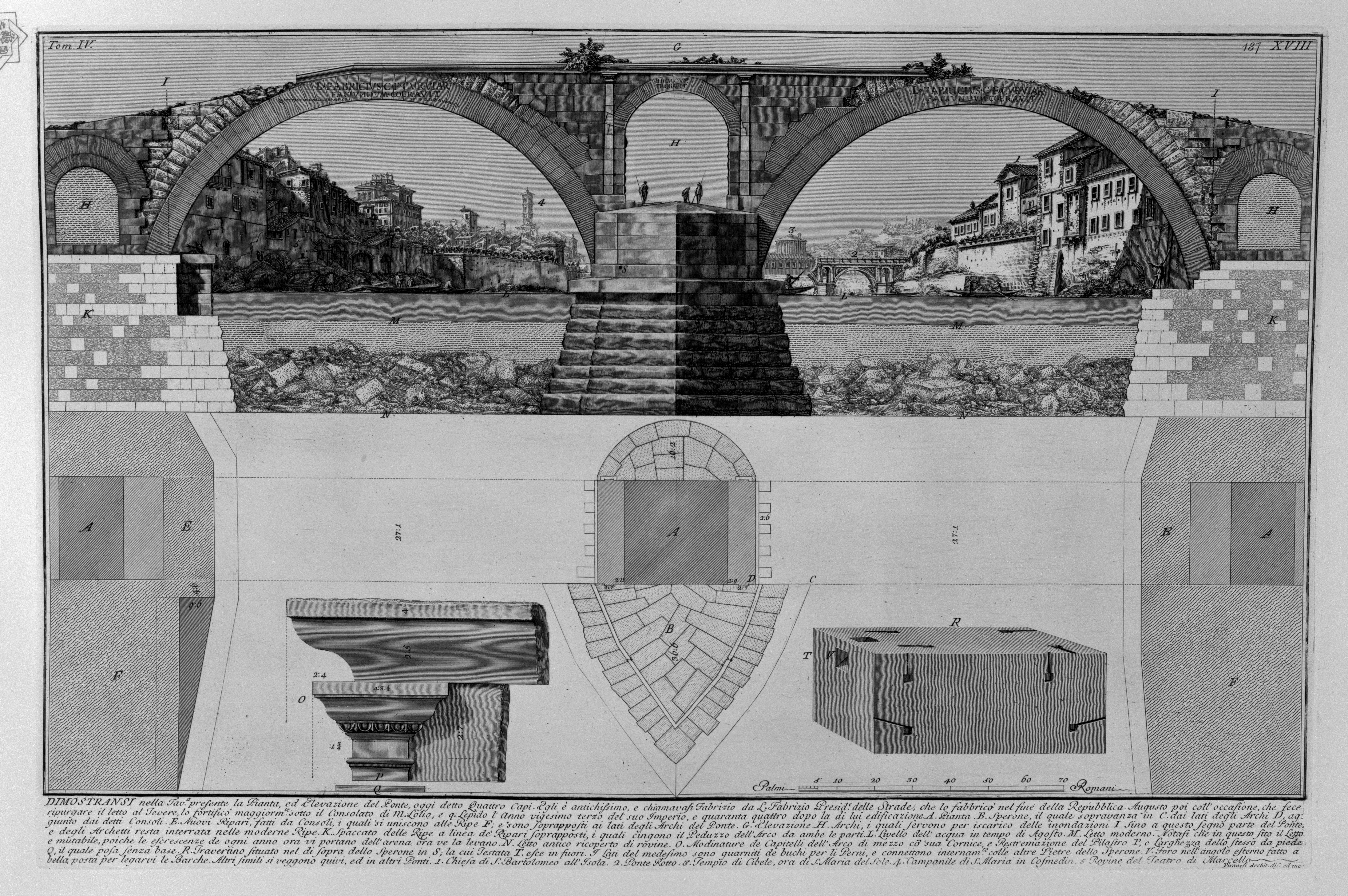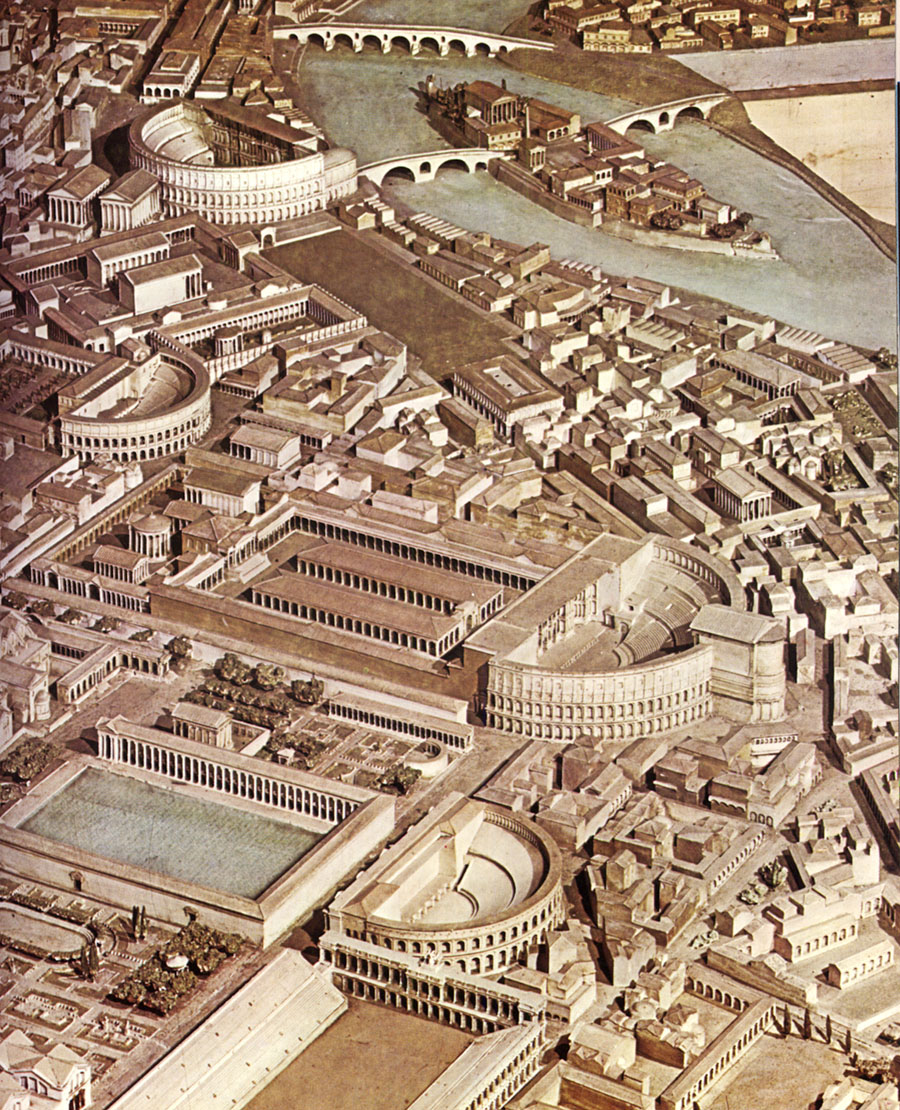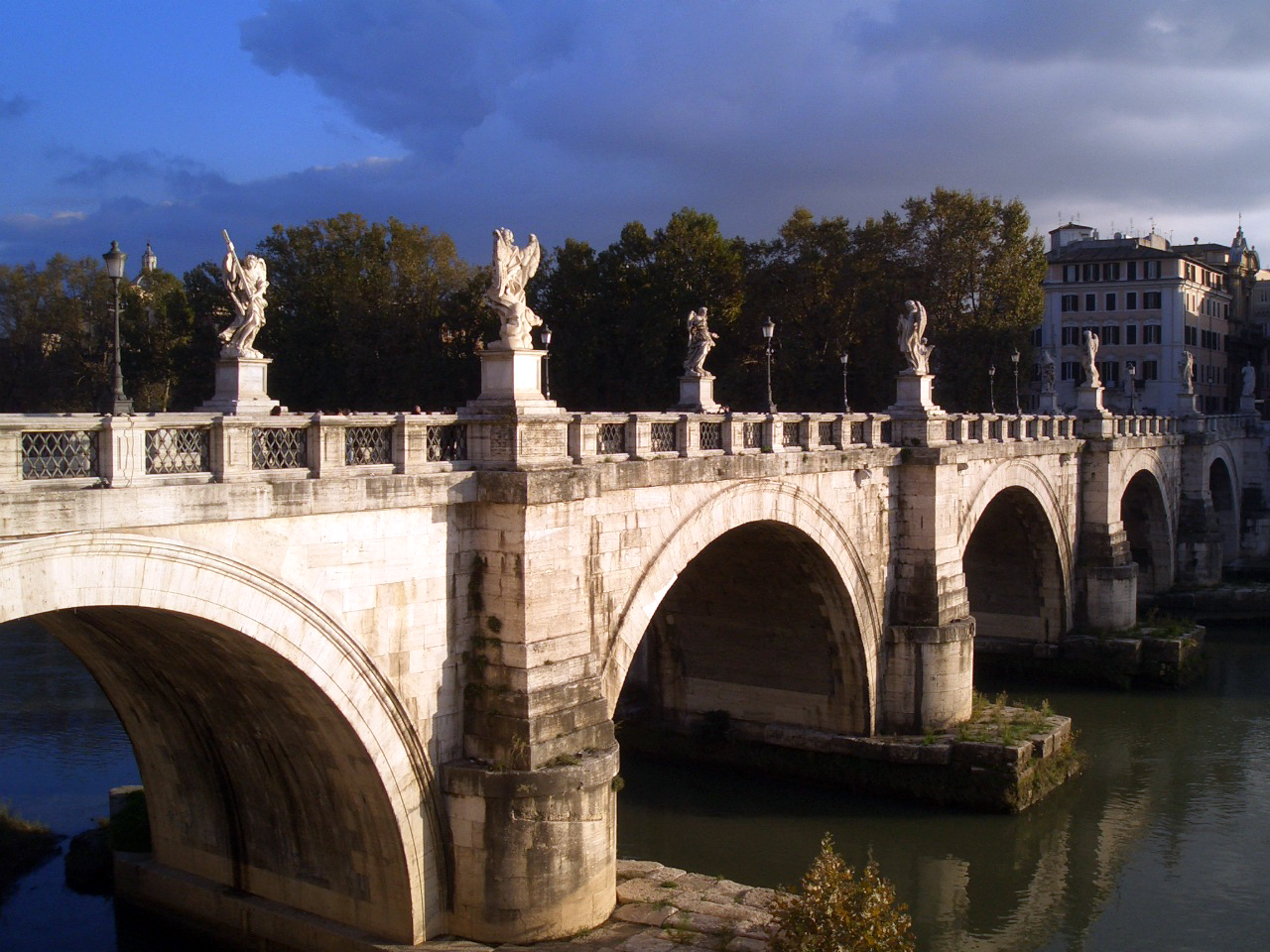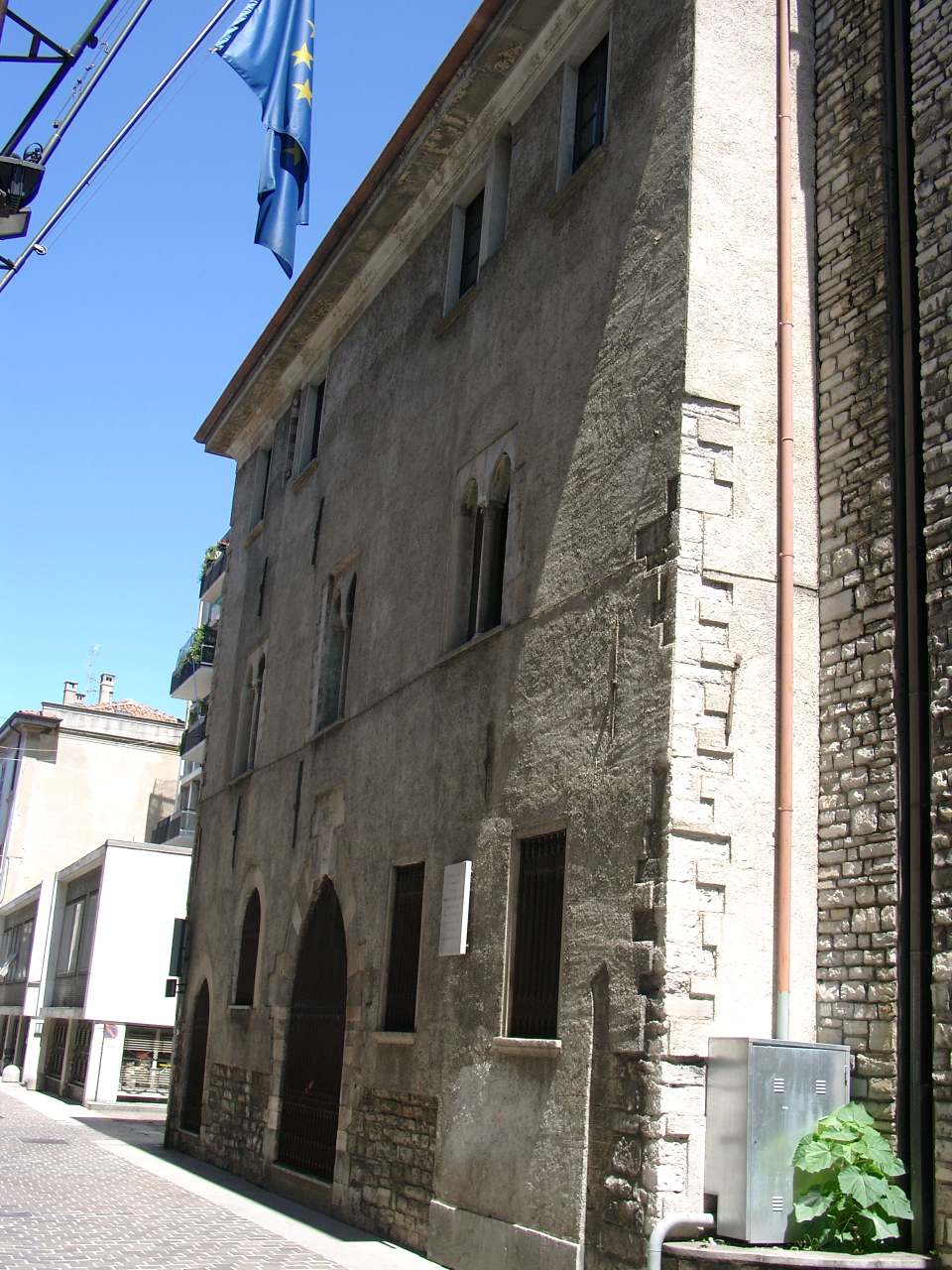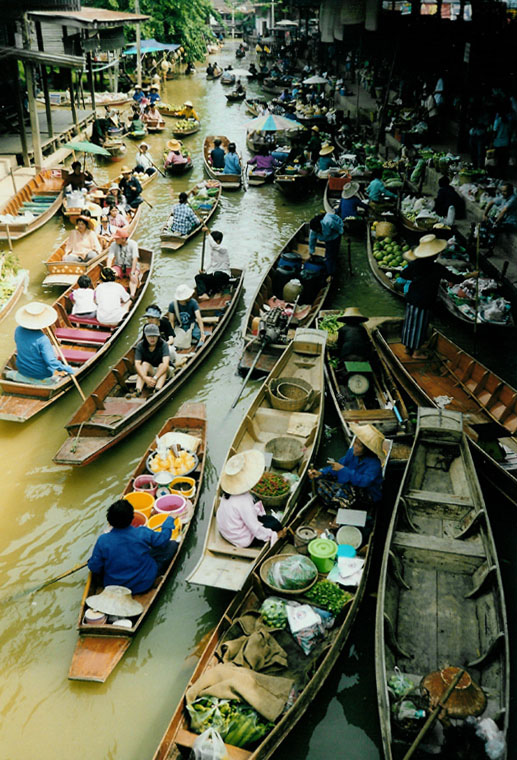|
Pons Fabricius
The Pons Fabricius ( it, Ponte Fabricio, "Fabrician Bridge") or Ponte dei Quattro Capi, is the oldest Roman bridge in Rome, Italy, still existing in its original state. Built in 62 BC, it spans half of the Tiber River, from the Campus Martius on the east side to Tiber Island in the middle (the Pons Cestius is west of the island). ''Quattro Capi'' ("four heads") refers to the two marble pillars of the two-faced Janus herms on the parapet, which were moved here from the nearby Church of St Gregory (Monte Savello) in the 14th century.Claridge, Amanda (1998). Rome: An Oxford Archaeological Guide'. Oxford: Oxford Univ. Press Bridge According to Dio Cassius, the bridge was built in 62 BC, the year after Cicero was consul, to replace an earlier wooden bridge destroyed by fire. It was commissioned by Lucius Fabricius, the curator of the roads and a member of the gens Fabricia of Rome. Completely intact from Roman antiquity, it has been in continuous use ever since. The Pons ... [...More Info...] [...Related Items...] OR: [Wikipedia] [Google] [Baidu] |
Campus Martius
The Campus Martius (Latin for the "Field of Mars", Italian ''Campo Marzio'') was a publicly owned area of ancient Rome about in extent. In the Middle Ages, it was the most populous area of Rome. The IV rione of Rome, Campo Marzio, which covers a smaller section of the original area, bears the same name. Antiquity According to Rome's foundation myth, prior to the founding of the city, Rhea Silvia had her twin sons, Romulus and Remus, taken by the King of Alba Longa. The boys were later discarded in the swelling Tiber River, which would later run along the Campus' western boundary. Washing ashore further downriver, the brothers would return decades later to found a new city. Romulus, who became Rome's sole king (after killing his brother Remus), ruled for many years until sometime in the seventh century B.C. As he came to the end of his life, a storm cloud descended upon the center of the open field outside the city's pomerium in order to lift the elderly king to heaven.Jacobs ... [...More Info...] [...Related Items...] OR: [Wikipedia] [Google] [Baidu] |
Tuff
Tuff is a type of rock made of volcanic ash ejected from a vent during a volcanic eruption. Following ejection and deposition, the ash is lithified into a solid rock. Rock that contains greater than 75% ash is considered tuff, while rock containing 25% to 75% ash is described as tuffaceous (for example, ''tuffaceous sandstone''). Tuff composed of sandy volcanic material can be referred to as volcanic sandstone. Tuff is a relatively soft rock, so it has been used for construction since ancient times. Because it is common in Italy, the Romans used it often for construction. The Rapa Nui people used it to make most of the ''moai'' statues on Easter Island. Tuff can be classified as either igneous or sedimentary rock. It is usually studied in the context of igneous petrology, although it is sometimes described using sedimentological terms. Tuff is often erroneously called tufa in guidebooks and in television programmes. Volcanic ash The material that is expelled in a volcanic ... [...More Info...] [...Related Items...] OR: [Wikipedia] [Google] [Baidu] |
Roman Bridges In Italy
Roman or Romans most often refers to: *Rome, the capital city of Italy *Ancient Rome, Roman civilization from 8th century BC to 5th century AD *Roman people, the people of ancient Rome *''Epistle to the Romans'', shortened to ''Romans'', a letter in the New Testament of the Christian Bible Roman or Romans may also refer to: Arts and entertainment Music * Romans (band), a Japanese pop group * ''Roman'' (album), by Sound Horizon, 2006 * ''Roman'' (EP), by Teen Top, 2011 *" Roman (My Dear Boy)", a 2004 single by Morning Musume Film and television *Film Roman, an American animation studio * ''Roman'' (film), a 2006 American suspense-horror film * ''Romans'' (2013 film), an Indian Malayalam comedy film * ''Romans'' (2017 film), a British drama film * ''The Romans'' (''Doctor Who''), a serial in British TV series People *Roman (given name), a given name, including a list of people and fictional characters *Roman (surname), including a list of people named Roman or Romans *Ῥωμα� ... [...More Info...] [...Related Items...] OR: [Wikipedia] [Google] [Baidu] |
Bridges In Rome
This is an incomplete list of bridges in the city of Rome, in Italy: * Pons Sublicius (around 642 BC) *Ponte di Castel Giubileo (built 1951) * Ponte di Tor di Quinto (1960) *Ponte Cestio (1st century BC), also called Ponte San Bartolomeo *Ponte Flaminio (1932–1951) * Ponte Milvio (207 BC; formerly called Ponte Mollo) * Ponte Nomentano (1st century BC) * Ponte Duca d'Aosta (1939–1942) * Ponte della Musica-Armando Trovajoli (2008–2011) *Ponte Risorgimento (1911) *Ponte Matteotti (1929; pre 1945 called Ponte delle Milizie or Ponte Littorio) *Ponte Nenni (1971–1972) * Ponte Regina Margherita (1886–1891, also called Ponte Margherita) * Ponte Cavour (1891–1896) * Ponte Umberto I (1885) * Ponte Sant'Angelo (134, formerly called Pons Aelius (Ponte Elio)) * Ponte Vittorio Emanuele II (1886–1911; also called Ponte Vittorio) * Ponte Principe Amedeo (1942, instead of Ponte dei Fiorentini) * Ponte Mazzini (1904–1908) * Ponte Sisto (1473–1479; instead of Po ... [...More Info...] [...Related Items...] OR: [Wikipedia] [Google] [Baidu] |
Ponte Milvio
The Milvian (or Mulvian) Bridge ( it, Ponte Milvio or ; la, Pons Milvius or ) is a bridge over the Tiber in northern Rome, Italy. It was an economically and strategically important bridge in the era of the Roman Empire and was the site of the famous Battle of the Milvian Bridge in 312, which led to the imperial rule of Constantine. Early history A bridge was built by consul Gaius Claudius Nero in 206 BC after he had defeated the Carthaginian army in the Battle of the Metaurus. In 109 BC, censor Marcus Aemilius Scaurus built a new bridge of stone in the same position, demolishing the old one. In 63 BC, letters from the conspirators of the Catiline conspiracy were intercepted here, allowing Cicero to read them to the Roman Senate the next day. In AD 312, Constantine I defeated his stronger rival Maxentius between this bridge and Saxa Rubra, in the famous Battle of the Milvian Bridge. During the Middle Ages, the bridge was renovated by a monk named Acuzio, and in 1429 Pope ... [...More Info...] [...Related Items...] OR: [Wikipedia] [Google] [Baidu] |
Roman Engineering
The ancient Romans were famous for their advanced engineering accomplishments. Technology for bringing running water into cities was developed in the east, but transformed by the Romans into a technology inconceivable in Greece. The architecture used in Rome was strongly influenced by Greek and Etruscan sources. Roads Roads were common at that time, but the Romans improved their design and perfected the construction to the extent that many of their roads are still in use today. Their accomplishments surpassed most other civilizations of their time, and after their time, and many of their structures have withstood the test of time to inspire others, especially during the Renaissance. Moreover, their contributions were described in some detail by authors such as Pliny the Elder, so there is a printed record of their many inventions and achievements. Aqueducts A thousand cubic metres (260,000 US gal) of water were brought into Rome by eleven different aqueducts each day. Per c ... [...More Info...] [...Related Items...] OR: [Wikipedia] [Google] [Baidu] |
Roman Architecture
Ancient Roman architecture adopted the external language of classical Greek architecture for the purposes of the ancient Romans, but was different from Greek buildings, becoming a new architectural style. The two styles are often considered one body of classical architecture. Roman architecture flourished in the Roman Republic and to even a greater extent under the Empire, when the great majority of surviving buildings were constructed. It used new materials, particularly Roman concrete, and newer technologies such as the arch and the dome to make buildings that were typically strong and well-engineered. Large numbers remain in some form across the former empire, sometimes complete and still in use to this day. Roman architecture covers the period from the establishment of the Roman Republic in 509 BC to about the 4th century AD, after which it becomes reclassified as Late Antique or Byzantine architecture. Few substantial examples survive from before about 100 BC, and most ... [...More Info...] [...Related Items...] OR: [Wikipedia] [Google] [Baidu] |
List Of Ancient Monuments In Rome
This is a list of ancient monuments from Republican and Imperial periods in the city of Rome, Italy. Amphitheaters * Amphitheater of Caligula * Amphitheatrum Castrense * Amphitheater of Nero * Amphitheater of Statilius Taurus * Colosseum Baths * Baths of Agrippa * Baths of Caracalla * Baths of Commodus * Baths of Constantine * Baths of Decius * Baths of Diocletian * Baths of Licinius Sura * Baths of Nero and Alexander * Baths of Septimius Severus * Baths of Titus * Baths of Trajan (later misnamed the Baths of Domitian) Circuses * Circus Flaminius * Circus Maximus * Circus of Maxentius * Circus of Nero * Circus Varianus Gardens * Gardens of Lucullus * Gardens of Maecenas * Gardens of Sallust * Horti Aciliorum * Horti Agrippinae * Horti Caesaris * Horti Domitiae * Horti Lamiani * Horti Liciniani * Horti Lolliani * Horti Pompeiani * Horti Tauriani Porticoes * Porticus Aemilia * Porticus Deorum Consentium * Porticus of Livia * Porticus Octavia * Porticus Octaviae ... [...More Info...] [...Related Items...] OR: [Wikipedia] [Google] [Baidu] |
List Of Roman Bridges
This is a list of Roman bridges. The Romans were the world's first major bridge builders. The following list constitutes an attempt to list all known surviving remains of Roman bridges. A Roman bridge in the sense of this article includes any of these features: *Roman arches *Roman pillars *Roman foundations *Roman abutments *Roman roadway *Roman cutwaters Also listed are bridges which feature substantially Roman material (spolia), as long as the later bridge is erected on the site of a Roman precursor. Finally, incidences where only inscriptions lay testimony to a former Roman bridge are also included. In the following, bridges are classified either according to their material or their function. Most data not otherwise marked come from O’Connor's ''Roman Bridges'', which lists 330 stone bridges for traffic, 34 timber bridges and 54 aqueduct bridges. An even larger compilation of more than 900 Roman bridges (as of 2011) is offered by the Italian scholar Galliazzo, who is ... [...More Info...] [...Related Items...] OR: [Wikipedia] [Google] [Baidu] |
Pope Innocent XI
Pope Innocent XI ( la, Innocentius XI; it, Innocenzo XI; 16 May 1611 – 12 August 1689), born Benedetto Odescalchi, was head of the Catholic Church and ruler of the Papal States from 21 September 1676 to his death on August 12, 1689. Political and religious tensions with Louis XIV of France were a constant preoccupation for Innocent XI. Within the Papal States, he lowered taxes, produced a surplus in the papal budget and repudiated nepotism within the Church. Innocent XI was frugal in his governance of the Papal States, his methods evident in matters ranging from his manner of dress to a wide range of standards of personal behavior consistent with his conception of Christian values. Once he was elected to the papacy, he applied himself to moral and administrative reform of the Roman Curia. He abolished sinecures and pushed for greater simplicity in preaching as well as greater reverence in worship, requesting this of both the clergy and faithful. In consideration of his di ... [...More Info...] [...Related Items...] OR: [Wikipedia] [Google] [Baidu] |
Ponte Fabricius From The Tiber River Walkway
Ponte, a word meaning '' bridge'' in Italian, Portuguese, and Galician languages, may refer to: Places England * Pontefract, a town in the Metropolitan City of Wakefield France *Ponte Leccia, a civil parish (hameau) in the department of Haute-Corse Italy ;Municipalities * Ponte (BN), in the Province of Benevento * Ponte Buggianese, in the Province of Pistoia * Ponte dell'Olio, in the Province of Piacenza * Ponte di Legno, in the Province of Brescia * Ponte di Piave, in the Province of Treviso *''Ponte Gardena'', Italian name for Waidbruck, in South Tyrol * Ponte in Valtellina, in the Province of Sondrio * Ponte Lambro, in the Province of Como * Ponte nelle Alpi, in the Province of Belluno *Ponte Nizza, in the Province of Provincia di Pavia * Ponte Nossa, in the Province of Bergamo * Ponte San Nicolò, in the Province of Padua * Ponte San Pietro, in the Province of Bergamo ;Civil parishes and quarters *Ponte (Rome) Ponte, a word meaning ''bridge'' in Italian, Portuguese, and G ... [...More Info...] [...Related Items...] OR: [Wikipedia] [Google] [Baidu] |
Waterway
A waterway is any navigable body of water. Broad distinctions are useful to avoid ambiguity, and disambiguation will be of varying importance depending on the nuance of the equivalent word in other languages. A first distinction is necessary between maritime shipping routes and waterways used by inland water craft. Maritime shipping routes cross oceans and seas, and some lakes, where navigability is assumed, and no engineering is required, except to provide the draft for deep-sea shipping to approach seaports (channels), or to provide a short cut across an isthmus; this is the function of ship canals. Dredged channels in the sea are not usually described as waterways. There is an exception to this initial distinction, essentially for legal purposes, see under international waters. Where seaports are located inland, they are approached through a waterway that could be termed "inland" but in practice is generally referred to as a "maritime waterway" (examples Seine Maritime, Loir ... [...More Info...] [...Related Items...] OR: [Wikipedia] [Google] [Baidu] |
